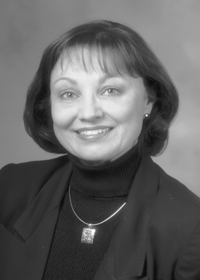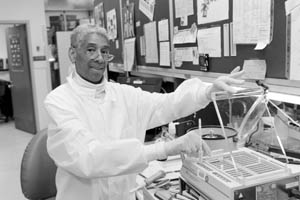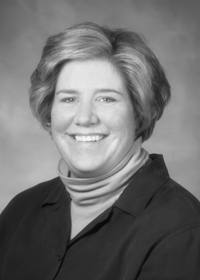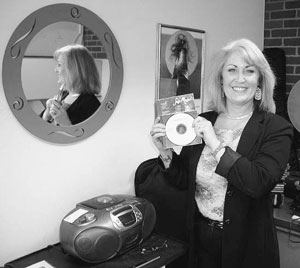|
New hospital activation plans
 Aerial photo taken in early January of the Mark O. Hatfield Clinical
Research Center with the building exterior virtually complete.
Aerial photo taken in early January of the Mark O. Hatfield Clinical
Research Center with the building exterior virtually complete.
|
Activation plans are being formulated in preparation for completion of the Mark
O. Hatfield Clinical Research Center. A CRC Steering Committee provides
oversight for the two main arms of the project-the hospital side and laboratory
side. In its overview role the committee concentrates on issues related
to the project schedule, budget, major changes, and occupancy.
For the hospital arm of the CRC project a Hospital Activation Management Team is responsible
for the leadership, oversight and management of daily operations for the hospital activation.
The team serves as a focal point for day-to-day issues related to CRC hospital activation planning;
makes decisions affecting CRC activation; seeks guidance and approvals from the Clinical Center
Research Steering and Medical Executive Committees on issues with broad monetary, operational, or
policy impact; develops and analyzes budgetary impact of activation plans; and informs the Research
Steering and Medical Executive Committees and other key stakeholders of the progress of the activation,
schedule and budget.
A number of CRC Work Groups have been established, for which the Hospital Activation Management Team also
provides guidance, support and oversight. These work groups and their respective roles include:
Facility Readiness. The Facility Readiness Work Group manages the transition from finished construction site
to readiness for occupancy. The group ensures the space is approved for use, equipped, furnished, stocked,
cleaned and secured. Members of this work group will participate in simulations for pre-occupancy and
occupancy of the CRC.
Relocation. The Relocation Work Group plans for the occupancy of each relocating department and patient care
unit space in the CRC. To accomplish this, task force groups representing each Clinical Center department
will be formed. The task force groups will plan the personnel and equipment relocations by reviewing
proposed methods and schedules and identifying any resource requirements necessary for the move.
Telecommunications. The Telecommunications Work Group ensures that the CRC hospital telecommunication
infrastructure needs are identified and cost-effectively satisfied to address voice (i.e., telephones
and telephone outlets), cable television and data (i.e., network, computers and printer outlets) requirements.
Communications and Education. The Communications and Education Work Group develops and coordinates
a plan for internal patients and patient affiliates, Clinical Center staff, and other facility users'
communications, tours and orientation materials. The plan will identify the various stakeholders (i.e.,
patients, visitors, staff, local community) and communication methods that will be used. The group will
also plan for the necessary training to familiarize staff with the new hospital spaces, systems,
equipment, and new methods or processes designed to conduct business. The group will plan the process
for developing the scripts and facility-based scenarios for simulation testing in preparation for occupancy.
Equipment. The Equipment Work Group identifies the necessary equipment and proposes appropriate sources,
using existing resources such as the Clinical Center Standardization Committee and departmental
representatives. The group will also coordinate both activation and operational equipment purchases.
Furniture. The Furniture Work Group develops criteria for the furniture/furnishings consultant to
use in selecting the furniture and furnishings for the hospital area and public spaces in the CRC.
The criteria will address matters such as standardization and safety as well as ease of cleaning
and maintenance, and accessibility to patients and individuals with disabilities.
Each of the relevant committees, work and task groups meets on a regularly scheduled basis with the
same end purpose in mind-to be ready for occupancy when the Mark O. Hatfield Clinical Research Center opens.
-by Dianne Needham
Back to Top
Nursing and Patient Care Services gets new program director

Linda Yoder, RN, Ph.D.
|
Linda Yoder, RN, Ph.D., is the new program director, Research and Outcomes Management,
for Nursing and Patient Care Services.
Recently retired as a colonel in the Army Nurse Corps with 28 years of service, Dr.
Yoder brings a distinguished record of contributions to nursing research and nursing
leadership and has published extensively in the clinical and administrative literature.
"I bring previous research, outcomes, and oncology/med-surg experience to this position and
I'm familiar with government service," she said. In her previous position, she built a bone
marrow transplant unit and a highly successful nursing research and outcomes service for an
Army medical center in Texas.
"I'm very passionate about my work as it relates to examining ways to make systems, services
and outcomes better for patients," she explained. "I look forward to the challenges, collaboration
and personal growth that I know I will experience by working here at the Clinical Center."
Dr. Yoder's initial priority will be to strengthen the infrastructure for research and outcomes
assessment within the Nursing Department. She will be taking time to get to know the staff and
understand the clinical setting.She will be talking to staff and managers about their clinical
practice interests, research interests and needs for support to become more involved in research.
"I have to admit that working at the NIH has been a dream of mine for years," she said.
"Currently the Clinical Center has nurses conducting various types of research in the
areas of pain and palliative care, health-related quality of life, symptom distress in
chronic illness, and teaching/learning methods for basic genetics content." Working as
part of collaborative healthcare teams to examine issues important to patients and to enhance
processes are two key goals. "I see my role as program director as being able to facilitate this,
while putting in place improvement initiatives to determine ways to best measure outcomes of care."
Back to Top
Shirley Gregg retires after 45 years of service
 Shirley Gregg was interviewed by Fox
TV-45 in Baltimore for a story about
the race riots during the 1960s. Gregg had to show a note to the National Guard every day
just to be able to leave her home to go to work during the riots.
Shirley Gregg was interviewed by Fox
TV-45 in Baltimore for a story about
the race riots during the 1960s. Gregg had to show a note to the National Guard every day
just to be able to leave her home to go to work during the riots.
|
Med. Tech. pioneer attributes her longevity to faith and life experiences
In 1958, Shirley Gregg prayed for a position as a medical technician in the Department of Transfusion Medicine.
"I prayed, Lord, if you give me this job, which was paying good money, then I wouldn't have to ever
ask for another position again," said Gregg.
And she kept her promise.
After 45 years of service, Gregg is retiring from the one job she really wanted more
than four decades ago. But it wasn't without its struggles.
Gregg has lived through bouts of discrimination, riots and just plain hard times,
but she has emerged with a good job, her own business and a spirit of helping others.
A native of Baltimore, Gregg was encouraged to go into the health profession by her friend's
father. "At that time, most African American women went into teaching. My friend's father was a
physician and told me more black females were needed in that field."
She attended school and received her certification from Provident Hospital in Baltimore,
and was later hired as the assistant supervisor of that hospital's blood bank.
After leaving Provident Hospital, Gregg said she came to the Clinical Center as the first
African American woman hired in the Department of Transfusion Medicine. "Of course at that time
there were some prejudices, but I was determined that they would have to run me out, because I
had the same thing going for me that they had going for them," she said.
But that was then. Now, her years of experience, leadership and training of many physicians
and other technicians, has earned her the respect of her colleagues.
"The department is losing a wonderful employee and friend," said Dr. Harvey Klein. "Shirley
taught me the basics of blood processing when I was a fellow some 30 years ago, and is remembered
fondly by a generation of physicians and technologists as a mainstay of the laboratory and
as a smiling and friendly face."
Gregg said through this position she has had the opportunity to travel and make presentations
at meetings and conferences, but most of all it has given her an opportunity to help other people.
"We have never wanted for anything, so if we can help someone along the way, then that is our
mission in life," said Gregg.
And that's a powerful mission for a woman who has gained a wealth of experience growing up as a
black female in Baltimore. During the 1960s, Gregg's dedication to her job placed her in the
middle of a riot-torn city.
"During the riots of the 1960s, I had to get a letter from Dr. Holland, then chief of the Blood Bank,
to get in and out of Baltimore," said Gregg. "The National Guard was at my corner every morning with
guns. The letter told them that I worked at NIH and that I was an essential employee and I was
expected to come to work in the morning. I showed the letter to the guy at the corner every
morning and every evening when I came back."
Gregg ran a family-owned business at that time selling beauty products for African Americans.
"Someone called us and said that they were rioting and burning buildings, and if you were a black
store owner, you had to hang a black sock on your door and the rioters would bypass your business,"
said Gregg. "That was the only thing that saved us, because in that block a lot of whites had
businesses there."
Gregg was determined to help the black community through her success in business, Gregg Enterprises.
"As blacks we had trouble getting loans from the banks because they didn't help Negroes,
or blacks, in business at that time. So I had to use the credit union here at the NIH,"
said Gregg. "As soon as I'd pay my bill down, I'd go back and get some more products."
Her products were beauty and cosmetic items for African Americans. Her business sold the
products to low-income people who did not have a credit card and could pay about $5 week for the products.
"We decided it would be a way to help poor people and it could also be a business," said Gregg."
She had nearly 40 people working on payroll.
But her willingness to help others didn't stop with her business. Gregg and her husband Archer,
put their two daughters, Cara and Audrey through college and also helped five other children,
not related to them, to get through college.
"We knew they were smart, they just needed to be given a chance," said Gregg. "By doing for others,
we have been blessed."
Additionally, Gregg is a member of the Women's Board of Ministries, a national organization that
helps abused women around the world. She is also an active member of Associated Black Charities,
Charlotte High Alumni Association-Baltimore Chapter, that gives scholarships to underprivileged students,
and she is a certified lay speaker with the United Methodist Church.
After her retirement, Gregg said she will spend much of her time teaching reading comprehension to first
and second grade students in the Baltimore City Schools. and spend more time with her 16-month-old grandson.
-by Tanya Brown
Back to Top
New director selected for Medical Record

Patricia Coffey
|
Patricia Coffey has been selected as the new director of the Medical Record Department effective Jan. 12.
Coffey has been a part of the Clinical Center since August 1990 and since then has mastered
every facet of the Medical Record Department by serving as section head or assistant section
head in every sector of the department.
"We are behind the scenes, but we play a key role," said Coffey. "We are the keepers of the
information. Our job is to provide complete and timely medical records for patient care and
medical research."
Coffey received her B.S. degree in Health Information Management from Ithaca College, New York,
in 1990 and received her Registered Health Information Administrator certification the same year.
Coffey then joined the Medical Record staff as the assistant section head, Record Processing Section
from 1990 to 1991. After that, she spent the next eight years as the section head for both the
Documentation Analysis and Coding Section, and the Record Management Section.
From 1997 to 2000, Coffey served as both the special assistant to the director and section head
of the Computer Applications Section and later served as acting director of the department until
her recent appointment.
As director, Coffey said her long-term goal is to bring the staff and the department into a new era
of handling electronic medical records.
"Our ultimate goal is to be paperless," said Coffey. "Nearly 80 percent of the records generated are
printed and then a copy is maintained." Everything that is not on paper is on microfiche, she said.
Coffey admits that part of that accomplishment will rely heavily upon the Clinical Research Information
System, a $60 million project that will tie together and support patient care, research and management
at the NIH Clinical Center.
But in the meantime, Coffey is slowly making strides. The department currently uses an electronic signature
that no longer requires physicians to leave their offices and labs and walk down to the Medical
Record Department to physically sign forms.
Coffey said the adjustment of moving from a support position to a department head takes some getting
used to, but she is ready to lead the department in the right direction.
"I'm looking forward to the challenges and the new trends in health and information management,"
said Coffey. "I work with some good people and I'm looking forward to moving the department forward."
Back to Top
Soothing the soul and healing the body with music
 Sheila Egan has integrated a music therapy program into the Rehabilitation Medicine
Department's Recreation Therapy section.
Sheila Egan has integrated a music therapy program into the Rehabilitation Medicine
Department's Recreation Therapy section.
|
Sheila Egan is a music therapist assigned to the Rehabilitation Medicine Department's
Recreation Therapy section. A singer by profession, she studied at the Boston Conservatory and
plays piano, guitar and drums. She sang opera and musical theater for years and has two CDs, one a
collection of meditations; the other a children's collection of songs.
Her career was demanding and she often performed eight shows a week at such places as the Kennedy
Center and the Washington National Cathedral. She also sang with the prestigious Boston Symphony
Orchestra. After being diagnosed with diabetes in the 1990s, however, she bailed out of the hectic
schedules and decided to teach singing.
"I had a number of students with chronic diseases," she says, "and I often found myself wondering
how I could use music to help them." She learned about music therapy and subsequently attended
the Shenandoah Conservatory in Winchester, Va. A single mom, she balanced her studies and home
life, graduating in three years. She did her internship working with Alzheimer's patients and
the elderly. She quickly saw past the infirmities into the people themselves—something she
does to this day. "I don't associate people with their conditions and often can't remember what
they're suffering from," she says. "I see them as who they are."
Modern musical therapy began in earnest in the 1950s, Egan said. But even after World War I,
amateur and professional musicians visited Veterans hospitals throughout the country, playing
for thousands of veterans suffering both physical and emotional trauma from the wars. This continued
after World War II as well. The first music therapy degree program was founded at Michigan State
University in 1944. In 1998, the National Association for Music Therapy and the American Association
for Music therapy joined to create the American Music Therapy Association.
When Egan came to NIH a year and a half ago, she found herself pioneering the music therapy program.
It was one of the exciting new therapies like massage, acupuncture and hypnotherapy finding their
respective niches at the Clinical Center. She found she was making a fresh start.
With a heritage that was part Native American, Egan found value not only in what she had
learned at Shenandoah, but in ancient Cherokee techniques that had been handed down to her. She
refuses to call it alternative therapy because she says it's used effectively with modern treatments and medicine.
Egan recalls the time she received a frantic call from the intensive care unit asking for urgent
help with a patient. "His blood pressure was going through the roof. His breathing was uneven-what
could I do?" Collecting her things, she visited the patient.
"What music do you like," she asked the patient. Classical, he replied. So Egan chose a soothing
classical CD containing music with a smooth and steady beat. Within five minutes, the patient's
blood pressure dropped and his anxiety dissipated.
"I always ask patients what they like," Egan says. "I'm a big believer in that. If someone doesn't
like the music, it won't be as effective."
Then there was the time a patient had alarmingly low blood pressure. This patient liked the Beatles,
Egan said, so she picked up a guitar and sang a lively tune that soon got the patient's heart pumping.
She has a legion of successes. One of her most sensational consisted of a young man who was suffering
from schizophrenia. "He would only listen to one song," Egan said. "What's worse, it was Limp Biscuit
of all things! For me and my generation, it is horrific music. And I thought, 'How am I going to
turn this into therapy?'"
Patient and therapist agreed on a course of action. The patient would come up with a dance
to go with the music and each week he'd come up with a routine. "He was so shy," Egan said, "but it
gave him something to do."With plenty of time to perfect his dance, the patient began
losing his shyness and his self-esteem improved. With practice, he was able to divert hallucinations
by going back to the song and the routine. And, as an added benefit, Egan says, the patient actually
performed his dance for his hospital unit and was a smashing success. "That he was able to use the
music to self-correct was amazing," she adds.
A study presented by Austrian researchers at the 10th World Congress of Pain, held in San Diego last
August, showed that music could be used as a tool to help relax muscles and dissolve tension. In
the study, 65 hospitalized patients with chronic low back pain after back surgery for a herniated disc
were randomly divided into two groups. Both groups got standard medical care and routine physical therapy.
But one group also received instruction on how to use relaxation imagery while listening to music.
The group that received the music and relaxation intervention listened to music every day for 25
minutes, using headphones. After three weeks, group members had substantially better pain relief.
They also said they had fewer sleep disturbances from the pain than did the group that did not
listen to the music.
Egan enthusiastically agrees that pain can be managed through music. "It's tight, like a clenched
fist," she explains. "When I sing, or when massage therapy is used, it lets up. Singing does the
same thing." With one patient, she hovered over an area with tumors and sang a strong steady note.
When asked about the effectiveness of singing to tumors, Egan cringes. "Oh, please, don't describe
it that way," she implores. Despite how it looks, she said, she's found it exceptionally effective.
"It's called 'toning,'" she corrected. One patient had a pain in his neck for two years,
she said. "Couldn't get rid of it. I did a couple of sessions with him and the pain disappeared
and has yet to come back.
Toning also has proven effective in relieving nausea in cancer patients, especially children.
"One child was so sick he was bent over a bucket. After 10 minutes of toning, he was sitting up and
wanting to watch TV."
Another aspect of music therapy are the recording sessions produced in a small studio at the Clinical
Center.
"We had some very talented people come through here," she says. "One was a rapper— terrific and
he writes his own tunes. When he came here, he thought of himself as a patient, someone who was sick.
But now he sees himself as a musician."
"Music therapy is a fine complementary addition to the Clinical Center," says George Patrick, chief of
the Rehabilitation Therapy section. Calling Egan "a gifted therapist," he adds that her skills
have been of great benefit to patients suffering from a wide variety of illnesses, including
the terminally ill. "Part of what drives her is the great energy and enthusiasm to improve the
quality of patient life. We are proud to have her as part of our team."
Staff interested in learning more about music therapy can attend a panel discussion and
poster session on Thursday, March 20, in the 14th floor Assembly Hall.
The Rehabilitation Medicine Department Grand Rounds will feature a music therapy
presentation on Friday, March 21 at 8:30 a.m. For further information, contact Sheila Egan at 301-402-0572.
-by John Iler
Back to Top
Quality of Worklife Initiative and Diversity Council
Resources help alleviate stress at work
Feeling blue? Having trouble concentrating? Experiencing conflicts at work?
Has stress from work or interpersonal issues got you down? Are you seeking a better
quality of life? There are many NIH-based and other resources available to help employees
and supervisors navigate the dark waters of conflict and stress. For example, consider the following:
The NIH Employee Assistance Program
301-496-3164
www.nih.gov/od/ors/ds/eap/
Provides confidential consultation services to help address difficult situations that may affect employees.
The NIH Center for Cooperative Resolution
301-594-7231
www4.od.nih.gov/ccr/
Provides confidential and informal assistance in resolving work-related conflicts or concerns.
The NIH Work and Family Life Center
301-435-1619
http://wflc.od.nih.gov/
Provides guidance and advice on balancing work, family, and career development needs.
CIVIL
301-453-0031
Provides advice, guidance and crisis intervention services regarding workplace violence,
threats and other aggressive behaviors at NIH.
Police Branch, Division of Public Safety
911 for emergencies.
301-496-5864 for non-emergencies.
www.nih.gov/od/ors/dps/
Provides assistance to employees:
National Domestic Violence Hotline
1-800-787-8224 or 1-800-799-SAFE
TDD: 1-800-787-3224
www.ojp.usdoj.gov/vawo/newhotline.htm.
Provides victim assistance and referral services.
Your assigned administrative officers (Office of Administrative Management and Planning, Building 10)
and personnel management specialists (Office of Human Resources Management, 6100 Executive Blvd.)
may also be helpful in providing advice and suggestions.
Back to Top
Training Programs in Clinical Research
Applications
for the 2003-2004 NIH-Duke Training Program in Clinical Research and the
University of Pittsburgh Training in Clinical Research Program are available
in Building 10, Room B1L403.
Duke Training Program in
Clinical Research
The NIH-Duke Training
Program in Clinical Research, implemented in 1998, is designed primarily for
physicians and dentists who desire formal training in the quantitative and
methodological principles of clinical research. The program, offered via
videoconference at the Clinical Center, allows the integration of a student's academic
coursework with his or her clinical training.
Academic credit earned by participating in this program may be applied toward
satisfying the degree requirement for a Master of Health Sciences in Clinical
Research from Duke University School of Medicine.
E-mail queries regarding the program may be addressed to tpcr@mc.duke.edu. The deadline for applying is March 1, 2003. Applicants who have been accepted into the program will be notified by July 1, 2003.
Pitt Training Program
The University of Pittsburgh Training
in Clinical Research Program, designed for Ph.D. and allied health professionals
(i.e., pharmacists and nurses), allows trainees to gain the knowledge and skills required
for the conduct of clinical investigation, as well as more extensive knowledge relative to a specific area of concentration.
Participants of this program have the option of receiving a Certificate in Clinical Research (15 credits) or a Master of Science in Clinical Research (30 credits) from the University of Pittsburgh.
For more information, send an e-mail to tcrp@imap.pitt.edu. The deadline for applying is March 1, 2003. Successful applicants will be notified by May 29, 2003.
Physicians and dentists are also eligible to matriculate in this program.
Back to Top
Studies
Post-Traumatic Stress Disorder
NIMH seeks adult volunteers who suffer from Post-Traumatic Stress Disorder (PTSD),
to participate in research studies that include mental health assessment, brain imaging
and/or a medication trial. Compensation is provided. Call 1-866-MAP-NIMH (1-866-627-6464); TTY 1-866-411-1010.
Sweat measuring study
NINDS seeks healthy children, ages 6-17, to participate in a sweat measuring study.
The sweat measuring test is non-invasive. Participation involves a one
hour outpatient visit. Compensation is provided. Call 1-800-892-3276 (TTY-1-866-411-1010). E-mail: prpl@cc.nih.gov.
Healthy identical twins study
The National Institutes of Health is conducting an immunological diversity study
for healthy identical twins, ages 18-35, involving two brief outpatient visits. History and physical, blood draws, apheresis, and questionnaires are involved. Both twins must participate and be in good health. Compensation is provided. Call 1-800-892-3276 (TTY-1-866-411-1010). E-mail: prpl@cc.nih.gov.
Listening/Hearing study
NIDCD seeks healthy people between the ages of 30-50 with normal hearing
for a listening study. English must be the first language. The study involves one
3 hour. visit to University of Maryland. for a hearing test, written language test,
and a series of listening tests. Compensation is provided. Call
1-800-892-3276 (TTY-1-866-411-1010). E-mail: prpl@cc.nih.gov.
Blood cell formation study
NIDDK seeks healthy African American males and females to participate
in a study to help understand the formation of white blood cells. Procedures include a
blood draw and limited physical and medical history. Participants must be between 18-50 yrs. old.
Compensation is provided. Call 1-800-892-3276 (TTY-1-866-411-1010). E-mail: prpl@cc.nih.gov.
February calendar
|
5
Grand Rounds
noon-1 p.m.
Masur Auditorium
Investigators' Obligations to Subjects and Their Families: How Should Conflicts Be Handled?
Wylie Burke, M.D., Ph.D., University of Washington
Wednesday Afternoon Lecture
3 p.m. Masur Auditorium
TBA
Jeanne Brooks-Gunn, Ph.D., Columbia University, New York, NY
|
12
Grand Rounds
noon-1 p.m. Masur Auditorium
Asthma Treatment in 2003
Jeffrey Drazen, M.D., Harvard Medical School, Boston, Ma.
Wednesday Afternoon Lecture
3 p.m. Masur Auditorium
Pathogenesis Studies of Polyglutamine-Induced Neurodegenerative Diseases
Huda Y. Zoghbi, M.D., Baylor College of Medicine, Houston, Tx
|
19
CRIS Grand Rounds
noon-1 p.m. Masur Auditorium
Creating Health Care's Next Era: The Role of Informatics
Martin D. Merry, M.S., CM, University of New Hampshire
Mission Possible: Safer Care for Clinical Research Patients
Bruce H. Berg, M.D., MBA, Sarasota Memorial Hospital, Fla.
Wednesday Afternoon Lecture
3 p.m. Masur Auditorium
Neural Correlates of Experienced Value in the Parietal Cortex
William T. Newsome, Ph.D., Stanford University, Palo Alto, Calif.
|
26
Grand Rounds
noon-1 p.m. Masur Auditorium
The Integration of Form and Function inthe Developing Fetus: Prenatal Predictors of Postnatal Outcome
Jeri Miller, Ph.D., CC/RMD, NICHD
Christian Macedonia, M.D., NNMC
Wednesday Afternoon Lecture
3 p.m. Masur Auditorium
Tinkering and Modeling of Genetic Networks
Stanislas Leibler, Ph.D., The Rockefeller Universityi, New York, NY
|
|
|
Back to Top
Editor:
Tanya C. Brown
Contributing
writers: Dianne Needham and John Iler
|
|
Clinical Center News, 6100 Executive Blvd., Suite 3C01, MSC 7511, National Institutes
of Health, Bethesda, MD 20892-7511. Tel: 301-496-2563. Fax: 301-402-2984.
Published monthly for CC employees by the Office of Clinical Center
Communications, Colleen Henrichsen, chief. News, article ideas, calendar
events, letters, and photographs are welcome. Deadline for submissions
is the second Monday of each month
.
Back to Top
|
|

